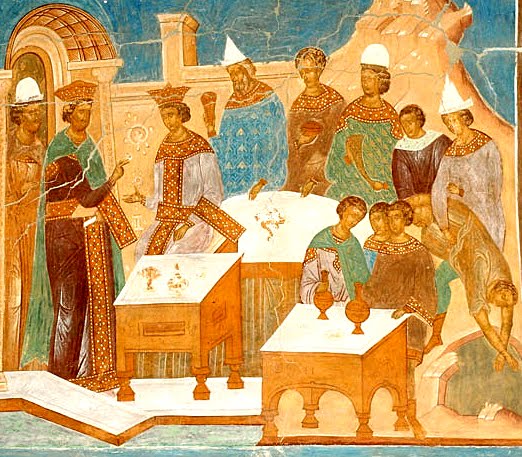
Twenty-eighth Sunday in Ordinary Time (Year “A”)—October 9, 2011
“FRIEND, HOW DID YOU GET IN HERE WITHOUT A WEDDING ROBE?”
[Texts: Isaiah 25.6-10 [Psalm 23]; Philippians 4.10-14,19-20; Matthew 22.1-14]
One feature of story-telling is the way certain kinds of stories get grouped together (parables of the Kingdom in the gospel tradition; jokes about lawyers or blondes on the internet). In narration, we often find a desire to be faithful to a story line combined with openness to creativity.
In New Testament parables, one notes a tendency to allegorize features of a story (“what was sown on rocky ground, this is the one who hears the word and immediately receives it with joy; yet such a person has no root...” and so on with the other seeds [Matthew 13.20-23]). Indeed, the parables of the wheat and weeds (13.24-30, 36-43) and the fishnet (13.47-50) are stories comprehensible only as allegories.
In Mark's parable of the wicked tenants, the son of the vineyard owner is seized, killed, and thrown out of the vineyard (12.8). In Matthew's version, we learn that “they seized him, threw him out of the vineyard and killed him” (21:39), paralleling what happened with Jesus, who was seized, taken out of Jerusalem and killed outside the walls.
Whether this slight modification—which makes the parable more closely parallel to the life of Jesus—is due to Jesus himself, evolving oral church tradition or the evangelist Matthew is, of course, the subject of scholarly debate.
The first part of today's gospel parable has parallels with a story found in the Lukan gospel (14.16-24), as well as significant differences. Basically the story deals with invitations to an important meal that those invited refuse for a variety of reasons—chiefly property and business—so that the host is obliged to invite others to take their places until the banquet hall is filled.
Luke's story concerns the “owner of a house” holding a “great dinner” to which he “invited many”, while the Matthean parable concerns a “king who gave a wedding banquet for his son”.
Already we can see how Matthew's parable can be applied to Christ. In Luke, only one servant is sent on several occasions; in Matthew, the king kept sending “slaves” in the hope of getting a response, and then “other slaves”.
When people begin to notice that Matthew's parable mirrors salvation history, they soon want to identify the messengers God has been sending to Israel
Was the king's judgment against the unresponsive invitees (“he sent his troops, destroyed those murderers, and burned their city”) simply an extraneous feature of the story reflecting royal reactions in Jesus' day? Or was it a prophecy of the destruction of Jerusalem Temple
This is where the matter of interpretation gets tricky and it is best to leave the matter open and unresolved, since allegorical interpretations may lead to people seeing a response from God towards Israel
The king's words to the man without the wedding garment (“friend, how did you get in here without a wedding robe?”) sound unfair. After all, did he not accept the invitation and come to the wedding feast? But if accepting the invitation means to become a disciple, sinners called need to repent and bear fruits of righteousness.
In Revelation 19.8, which speaks about the marriage feast of the Lamb, the bride of Christ—the Church—is dressed in “fine linen, bright and pure”. This gets interpreted, “for the fine linen is the righteous deeds of the saints”.
The gospel's closing statement, “many are called, but few are chosen” is likely an instance of a Semitic universalizing statement that is best translated, “all are called, but not all are chosen”. Those “called” must become “chosen” by allowing God's grace to work righteous deeds in their lives.
* * * * * *
NEW ST. PATRICK'S HOME
SLATED FOR CONSTRUCTION
A few weeks ago, I was invited to St. Patrick's Home for Seniors on Riverside Drive to view the site plans for the New St. Patrick's Home to be built in the coming months on the same grounds as the current home.
The layout and structure will take into account the new realities that seniors come to the home later in life and with greater accessibility needs. This requires space for wheelchairs and mobile chairs.
The new facility will continue to have a chapel, but now designated as a the Marguerite d'Youville Space, with a small oratory for Eucharistic adoration beside it.
The Grey Sisters of the Immaculate Conception, who are major donors to the new home (as they contributed to the Home in the past), are very pleased with the plans and posed with me. [The Archdiocese of Ottawa contributed to the new home with a multi-year pledge.]
All look forward to the opening of the new St. Patrick's in the next two years.





No comments:
Post a Comment